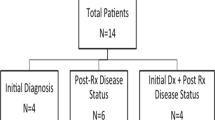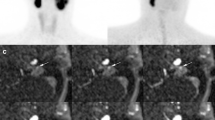Abstract
Purpose
Specific recommendations on screening modalities for paraganglioma (PGL) and phaeochromocytoma (PCC) in asymptomatic SDHx mutation carriers (relatives) are still lacking. We evaluated the added value of 18F-FDG PET/CT in comparison with morphological imaging at initial diagnosis and 1 year of follow-up in this population.
Methods
The study included 30 consecutive relatives with a proven SDHx mutation who were investigated by 18F-FDG PET/CT, gadolinium-enhanced magnetic resonance angiography of the head and neck, thoracic/abdominal/pelvic (TAP) contrast-enhanced CT and/or TAP MRI. 123I-MIBG scintigraphy was performed in 20 subjects and somatostatin receptor scintigraphy (SRS) in 20 subjects. The gold standard was based on pathology or a composite endpoint as defined by any other positive imaging method and persistent tumour on follow-up. Images were considered as false-positive when the lesions were not detected by another imaging method or not confirmed at 1 year.
Results
At initial work-up, an imaging abnormality was found in eight subjects (27 %). The final diagnosis was true-positive in five subjects (two with abdominal PGL, one with PCC and two with neck PGL) and false-positives in the other three subjects (detected with 18F-FDG PET/CT in two and TAP MRI in one). At 1 year, an imaging abnormality was found in three subjects of which one was an 8-mm carotid body PGL in a patient with SDHD mutaion and two were considered false-positive. The tumour detection rate was 100 % for 18F-FDG PET/CT and conventional imaging, 80 % for SRS and 60 % for 123I-MIBG scintigraphy. Overall, disease was detected in 4 % of the subjects at the 1-year follow-up.
Conclusion
18F-FDG PET/CT demonstrated excellent sensitivity but intermediate specificity justifying combined modality imaging in these patients. Given the slow progression of the disease, if 18F-FDG PET/CT and MRI are normal at baseline, the second imaging work-up should be delayed and an examination that does not expose the patient to radiation should be used.




Similar content being viewed by others
References
Amar L, Baudin E, Burnichon N, Peyrard S, Silvera S, Bertherat J, et al. Succinate dehydrogenase B gene mutations predict survival in patients with malignant pheochromocytomas or paragangliomas. J Clin Endocrinol Metab. 2007;92(10):3822–8. doi:10.1210/jc.2007-0709.
Gimenez-Roqueplo AP, Favier J, Rustin P, Rieubland C, Crespin M, Nau V, et al. Mutations in the SDHB gene are associated with extra-adrenal and/or malignant phaeochromocytomas. Cancer Res. 2003;63(17):5615–21.
Benn DE, Gimenez-Roqueplo AP, Reilly JR, Bertherat J, Burgess J, Byth K, et al. Clinical presentation and penetrance of pheochromocytoma/paraganglioma syndromes. J Clin Endocrinol Metab. 2006;91(3):827–36. doi:10.1210/jc.2005-1862.
Pasini B, Stratakis CA. SDH mutations in tumorigenesis and inherited endocrine tumours: lesson from the phaeochromocytoma-paraganglioma syndromes. J Intern Med. 2009;266(1):19–42. doi:10.1111/j.1365-2796.2009.02111.x.
Taieb D, Sebag F, Barlier A, Tessonnier L, Palazzo FF, Morange I, et al. 18F-FDG avidity of pheochromocytomas and paragangliomas: a new molecular imaging signature? J Nucl Med. 2009;50(5):711–7. doi:10.2967/jnumed.108.060731.
Timmers HJ, Kozupa A, Chen CC, Carrasquillo JA, Ling A, Eisenhofer G, et al. Superiority of fluorodeoxyglucose positron emission tomography to other functional imaging techniques in the evaluation of metastatic SDHB-associated pheochromocytoma and paraganglioma. J Clin Oncol. 2007;25(16):2262–9. doi:10.1200/JCO.2006.09.6297.
King KS, Chen CC, Alexopoulos DK, Whatley MA, Reynolds JC, Patronas N, et al. Functional imaging of SDHx-related head and neck paragangliomas: comparison of 18F-fluorodihydroxyphenylalanine, 18F-fluorodopamine, 18F-fluoro-2-deoxy-D-glucose PET, 123I-metaiodobenzylguanidine scintigraphy, and 111In-pentetreotide scintigraphy. J Clin Endocrinol Metab. 2011;96(9):2779–85. doi:10.1210/jc.2011-0333.
Treglia G, Cocciolillo F, de Waure C, Di Nardo F, Gualano MR, Castaldi P, et al. Diagnostic performance of 18F-dihydroxyphenylalanine positron emission tomography in patients with paraganglioma: a meta-analysis. Eur J Nucl Med Mol Imaging. 2012;39(7):1144–53. doi:10.1007/s00259-012-2087-y.
Hoegerle S, Ghanem N, Altehoefer C, Schipper J, Brink I, Moser E, et al. 18F-DOPA positron emission tomography for the detection of glomus tumours. Eur J Nucl Med Mol Imaging. 2003;30(5):689–94. doi:10.1007/s00259-003-1115-3.
Lenders JW, Duh QY, Eisenhofer G, Gimenez-Roqueplo AP, Grebe SK, Murad MH, et al. Pheochromocytoma and paraganglioma: an endocrine society clinical practice guideline. J Clin Endocrinol Metab. 2014;99(6):1915–42. doi:10.1210/jc.2014-1498.
Taieb D, Timmers HJ, Hindie E, Guillet BA, Neumann HP, Walz MK, et al. EANM 2012 guidelines for radionuclide imaging of phaeochromocytoma and paraganglioma. Eur J Nucl Med Mol Imaging. 2012;39(12):1977–95. doi:10.1007/s00259-012-2215-8.
Gimenez-Roqueplo AP, Caumont-Prim A, Houzard C, Hignette C, Hernigou A, Halimi P, et al. Imaging work-up for screening of paraganglioma and pheochromocytoma in SDHx mutation carriers: a multicenter prospective study from the PGL.EVA Investigators. J Clin Endocrinol Metab. 2013;98(1):E162–73.
Plouin PF, Degoulet P, Tugaye A, Ducrocq MB, Menard J. Screening for phaeochromocytoma: in which hypertensive patients? A semiological study of 2585 patients, including 11 with phaeochromocytoma (author’s transl). Nouv Presse Med. 1981;10(11):869–72.
Kairisto V, Koskinen P, Mattila K, Puikkonen J, Virtanen A, Kantola I, et al. Reference intervals for 24-h urinary normetanephrine, metanephrine, and 3-methoxy-4-hydroxymandelic acid in hypertensive patients. Clin Chem. 1992;38(3):416–20.
Lenders JW, Eisenhofer G, Mannelli M, Pacak K. Phaeochromocytoma. Lancet. 2005;366(9486):665–75. doi:10.1016/S0140-6736(05)67139-5.
Kwekkeboom DJ, Bakker WH, Kam BL, Teunissen JJ, Kooij PP, de Herder WW, et al. Treatment of patients with gastro-entero-pancreatic (GEP) tumours with the novel radiolabelled somatostatin analogue [177Lu-DOTA(0),Tyr3]octreotate. Eur J Nucl Med Mol Imaging. 2003;30(3):417–22. doi:10.1007/s00259-002-1050-8.
Timmers HJ, Chen CC, Carrasquillo JA, Whatley M, Ling A, Eisenhofer G, et al. Staging and functional characterization of pheochromocytoma and paraganglioma by 18F-fluorodeoxyglucose (18F-FDG) positron emission tomography. J Natl Cancer Inst. 2012;104(9):700–8. doi:10.1093/jnci/djs188.
Taieb D, Neumann H, Rubello D, Al-Nahhas A, Guillet B, Hindie E. Modern nuclear imaging for paragangliomas: beyond SPECT. J Nucl Med. 2012;53(2):264–74. doi:10.2967/jnumed.111.098152.
Jasperson KW, Kohlmann W, Gammon A, Slack H, Buchmann L, Hunt J, et al. Role of rapid sequence whole-body MRI screening in SDH-associated hereditary paraganglioma families. Familial Cancer. 2014;13(2):257–65. doi:10.1007/s10689-013-9639-6.
Acknowledgments
Seventeen patients were previously enrolled in the PGL.EVA study supported by Program Hospitalier National de Recherche Clinique 2004 (PCR05007).
Compliance with Ethical Standards
ᅟ
Conflicts of Interest
None.
Research Involving Human Participants
For this type of retrospective study formal consent is not required.
Author information
Authors and Affiliations
Corresponding author
Rights and permissions
About this article
Cite this article
Lepoutre-Lussey, C., Caramella, C., Bidault, F. et al. Screening in asymptomatic SDHx mutation carriers: added value of 18F-FDG PET/CT at initial diagnosis and 1-year follow-up. Eur J Nucl Med Mol Imaging 42, 868–876 (2015). https://doi.org/10.1007/s00259-015-3003-z
Received:
Accepted:
Published:
Issue Date:
DOI: https://doi.org/10.1007/s00259-015-3003-z




